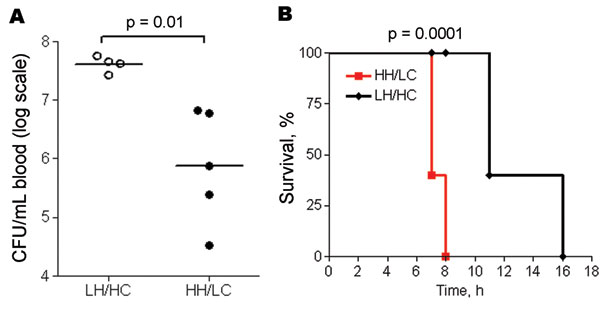Volume 15, Number 2—February 2009
Research
Bacterial Phenotype Variants in Group B Streptococcal Toxic Shock Syndrome1
Figure 6

Figure 6. Murine toxic shock model (high inoculum). Groups of 5 mice were inoculated intraperitoneally with 5–7 × 107 CFU of low hemolytic (LH)/high encapsulation (HC) or high hemolytic (HH)/low encapsulation (LC) group B streptococcal isolates per mouse. A) Level of bacteremia assessed after 6 h. Horizontal lines indicate the median. B) Kaplan-Meier survival plot.
1Part of this work was presented at Lancefield 2008 International Symposium on Streptococci and Streptococcal Diseases, Porto Heli, Greece, June 22–26, 2008.
2Current affiliation: Clinic for Infectious Diseases, University Hospital Bern, Bern, Switzerland.
Page created: December 08, 2010
Page updated: December 08, 2010
Page reviewed: December 08, 2010
The conclusions, findings, and opinions expressed by authors contributing to this journal do not necessarily reflect the official position of the U.S. Department of Health and Human Services, the Public Health Service, the Centers for Disease Control and Prevention, or the authors' affiliated institutions. Use of trade names is for identification only and does not imply endorsement by any of the groups named above.